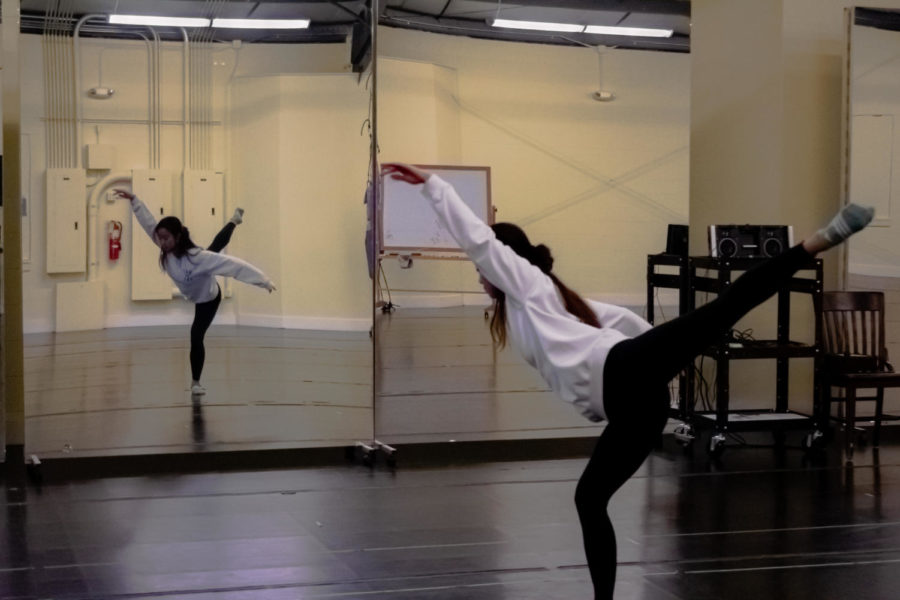W&L dance students petition for P.E. credit
Balancing dance with other required P.E. courses often leads to injury
Angela Tu, ’24, started the petition to raise awareness for the amount of time and effort dancers put into their dance courses. Photo by Elena Lee ’25.
March 29, 2022
Students in the Washington and Lee Repertory Dance Company are petitioning to receive physical education credit for their dance courses.
Angela Tu, ’24, started the petition to raise awareness about the time commitment and physical toll of being a dancer at Washington and Lee — and ask for fair recognition from the university. As of Sunday, 231 people have already signed the petition.
“You really have to enjoy [dance company] and love it so much, because you don’t really get a lot of credits for the time that you spend in it,” Tu said. “I literally just made a petition because I was looking at my course load [for next semester] and was like, I can’t fit in one P.E. credit with dance classes that I’m taking.”
Students in the dance company typically take the 1-credit university dance course every semester for all four years. Dance minors, like Tu, are required to take the course three times — but outside of the minor, it only counts for experiential learning credit.
“Everyone in dance company says I’m putting more time into this one credit experiential, that won’t help us with anything, than any class we’ve ever taken,” Tu said.
Tu said during the week leading up to performances, dance students spend every day from 6 p.m. until 11 p.m. rehearsing. But that’s only part of their time commitment.
“During fall term, we met for two hours on Tuesday, adding to already 6-7 hours every week,” Tu said. “And then during winter term, we pay these choreographers to come for a weekend. And we work on [a dance] for 15 plus hours in the span of two days. Our bodies feel like they’re hit by a truck.”
Members in the dance company also meet for an extra hour and a half every week.
But the main reason for the petition stems from the frequent injuries students receive from trying to balance both dance courses and other physical education courses to fulfill the university’s requirements.
“Last year, I was taking aerobic running at the same time as dance company, and I got like, really, really bad shin splints, because like, running and dancing a lot at the same time was just terrible for my body,” said Ashley Shugart, ’22, president of the W&L Repertory Dance Company.
This is not an uncommon experience, Shugart said. Many dance students wind up with shin splints or other overuse injuries.
Tu, who has also had shin splints, said this problem is made worse by the fact that the dance company doesn’t have access to athletic trainers, like university sports teams do.
“I got terrible shin splints for my show. It was like the worst pain I’ve ever experienced,” Tu said. “I had to dance for like five hours on my shin splints.”
Sports teams also receive P.E. credit for participating on their teams — a recognition that dancers are not granted.
“My roommate on the field hockey team, she completes two of her P.E. credits by taking field hockey. For dance, you don’t get anything,” said Kate Fisher, ’23, a member of the dance company. “We think that it should be recognized in some way.”
Many students signed the petition because they had taken a dance class before, and found it to be as physically demanding and educational — if not more — than other P.E. courses.
“The problem I’ve always had with the P.E. classes is that I don’t know how productive they are to actual learning, in terms of transferable skills,” said Wren Markley, ’23. “But with dance, I actually learned about my body. My professor showed me a stretch to help with a leg injury.”
Students recognize that changing the credit status for dance classes might not be easy.
“I know, part of its like, tricky with dance, because it’s like, technically an art form,” Shugart said. “And there might be some weird things like with requirements around what constitutes what.”
Provost Paul Youngman said in an email that curriculum discussions like this begin within the departments themselves. Tu said she plans to bring her petition to the deans sometime this week to get the conversation started — especially since the petition received more support from students than she expected.
“I think it definitely shows that especially at a small school like this, people genuinely care,” Tu said. “It’s really cool to see.”
Fisher said now it’s time for the university to show their support.
“If you want to grow the program, if you want to grow the arts, if you truly are a liberal arts school, you would value the benefits that dance adds to people’s lives,” Fisher said. “Why is dance not considered physical education when it actually is educational and definitely physical?”



